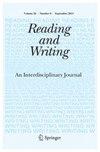Cross-sectional examination of the proficiency of year 1 and year 2 children’s alphabet-letter-writing skills
IF 2.2
2区 教育学
Q2 EDUCATION & EDUCATIONAL RESEARCH
引用次数: 0
Abstract
Abstract The objective for beginning writers is to learn how to generate alphabet-letters which are recognisable and easy to read. This study investigated the accuracy of Year 1 and 2 children’s alphabet-letter-writing by evaluating their alphabet and orthographic knowledge, following evidence which identifies these skills as important for correctly representing the Latin alphabet-letters in written form. 408 typical children from the first two years of formal schooling were recruited from eight Western Australian schools and asked to write the twenty-six-lowercase alphabet-letters under three different writing conditions: from memory; the initial sounds of words; and copying. Performance was measured using the Perceive, Recall, Plan and Perform (PRPP) System of Task Analysis (Stage One). Analyses revealed the mean average number of the 26- lowercase alphabet-letters correctly written from memory was 8.17 (Year 1) and 12.76 (Year 2). Mean averages were similar across the three writing conditions. Comparative analysis showed children in Year 2 were significantly better than Year 1 children at recalling the alphabet-sequence, sound-letter-translation, and retrieving the letter-shape, letter-case, and letter-orientation. No significant difference was found in name-to-letter translation, letter-formation, or letter-placement skills. The results highlighted that many typical Year 1 and 2 children have difficulty accurately generating all 26- lowercase alphabet-letters. The findings suggested that the way early writers learn to form and place an alphabet-letter, whether it is accurate or not, is how they continue to write the alphabet-letter through their early school journey. Considerations for evaluation and instruction of alphabet-letter-writing are discussed.

一年级和二年级儿童字母书写能力的横断面测试
初级写作者的目标是学习如何生成可识别且易于阅读的字母。本研究通过评估一年级和二年级儿童的字母和正字法知识,调查了他们字母-字母书写的准确性。有证据表明,这些技能对于正确书写拉丁字母很重要。从澳大利亚西部的八所学校招募了408名接受过两年正规教育的典型儿童,要求他们在三种不同的书写条件下写出26个小写字母:记忆;单词的开头音;和复制。使用任务分析(第一阶段)的感知、回忆、计划和执行(PRPP)系统来测量绩效。分析显示,学生从记忆中正确写出26个小写字母的平均数为8.17个(一年级)和12.76个(二年级)。三种书写条件下的平均数相似。对比分析显示,二年级儿童在字母顺序记忆、读音-字母翻译记忆、字母形状、字母大小写和字母方位记忆等方面明显优于一年级儿童。在姓名到字母的翻译、字母的形成或字母的放置技能方面没有发现显著差异。结果突出表明,许多典型的一年级和二年级的孩子很难准确地生成所有26个小写字母。研究结果表明,早期写信人学习形成和放置字母的方式,无论准确与否,都是他们在早期学校学习过程中继续书写字母的方式。讨论了字母书写评价和教学的注意事项。
本文章由计算机程序翻译,如有差异,请以英文原文为准。
求助全文
约1分钟内获得全文
求助全文
来源期刊

Reading and Writing
Multiple-
CiteScore
5.20
自引率
16.00%
发文量
0
期刊介绍:
Reading and writing skills are fundamental to literacy. Consequently, the processes involved in reading and writing and the failure to acquire these skills, as well as the loss of once well-developed reading and writing abilities have been the targets of intense research activity involving professionals from a variety of disciplines, such as neuropsychology, cognitive psychology, psycholinguistics and education. The findings that have emanated from this research are most often written up in a lingua that is specific to the particular discipline involved, and are published in specialized journals. This generally leaves the expert in one area almost totally unaware of what may be taking place in any area other than their own. Reading and Writing cuts through this fog of jargon, breaking down the artificial boundaries between disciplines. The journal focuses on the interaction among various fields, such as linguistics, information processing, neuropsychology, cognitive psychology, speech and hearing science and education. Reading and Writing publishes high-quality, scientific articles pertaining to the processes, acquisition, and loss of reading and writing skills. The journal fully represents the necessarily interdisciplinary nature of research in the field, focusing on the interaction among various disciplines, such as linguistics, information processing, neuropsychology, cognitive psychology, speech and hearing science and education. Coverage in Reading and Writing includes models of reading, writing and spelling at all age levels; orthography and its relation to reading and writing; computer literacy; cross-cultural studies; and developmental and acquired disorders of reading and writing. It publishes research articles, critical reviews, theoretical papers, and case studies. Reading and Writing is one of the most highly cited journals in Education, Educational Research, and Educational Psychology.
 求助内容:
求助内容: 应助结果提醒方式:
应助结果提醒方式:


